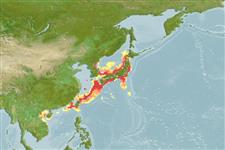>
Albuliformes (Bonefishes) >
Albulidae (Bonefishes) > Pterothrissinae
Etymology: Pterothrissus: Greek,pteron = wing, fin + Greek, thrissa, -es = shad (Ref. 45335).
More on author: Hilgendorf.
Environment: milieu / climate zone / depth range / distribution range
Ökologie
seewasser benthopelagisch; tiefenbereich 147 - 1000 m (Ref. 50610). Temperate; 49°N - 15°N, 105°E - 149°E
Northwest Pacific: Japan (Ref. 559), China (Ref. 47439) and Russia (56557).
Size / Gewicht / Alter
Maturity: Lm ? range ? - ? cm
Max length : 50.0 cm TL Männchen/unbestimmt; (Ref. 56557)
Rückenflossenstacheln (insgesamt): 0; Rückenflossenweichstrahlen (insgesamt): 54-65; Afterflossenstacheln 0; Afterflossenweichstrahlen: 10 - 13; Wirbelzahl: 105 - 107. This species is distinguished by the following set of characters (holotype measurements in parentheses): supraneural bones 6-7; dorsal-fin rays 54-65 (mode 58); total vertebrae 105-107 (107); pored lateral-line scales 99-109 (105); pre-dorsal scale rows 13-20 (16); head length 23-31 % (mean 27 %) of SL; pectoral-fin length 10-18 % (15 %) of SL; pre-dorsal-fin length 31-39 % (35 %) of SL; dorsal-fin base length 47-56 % (52 %) of SL; postorbital length 9-12 % (10 %) of SL; upper caudal-fin length 16-32 % (21 %) of SL (Ref. 109573).
Found in deep waters.
Life cycle and mating behavior
Geschlechtsreife | Fortpflanzung | Ablaichen | Eier | Fecundity | Larven
Spawning occurs in open waters. Eggs are pelagic (Ref. 205).
Masuda, H., K. Amaoka, C. Araga, T. Uyeno and T. Yoshino, 1984. The fishes of the Japanese Archipelago. Vol. 1. Tokai University Press, Tokyo, Japan. 437 p. (text). (Ref. 559)
IUCN Rote Liste Status (Ref. 130435)
Bedrohung für Menschen
Harmless
Nutzung durch Menschen
Mehr Information
ReferenzenAquakulturAquakultur ProfilZuchtlinienGenetikElectrophoresesVererbbarkeitKrankheitenVerarbeitungNutrientsMass conversion
PartnerBilderStamps, Coins Misc.LauteCiguateraGeschwindigkeitSchwimmstilKiemenoberflächeOtolithsGehirngrößeSehfähigkeit
Tools
Zusatzinformationen
Download XML
Internet Quellen
Estimates based on models
Preferred temperature (Ref.
123201): 0.6 - 13.8, mean 8.6 °C (based on 65 cells).
Phylogenetic diversity index (Ref.
82804): PD
50 = 1.0002 [Uniqueness, from 0.5 = low to 2.0 = high].
Bayesian length-weight: a=0.01122 (0.00514 - 0.02450), b=3.04 (2.87 - 3.21), in cm total length, based on all LWR estimates for this body shape (Ref.
93245).
Trophic level (Ref.
69278): 3.3 ±0.2 se; based on diet studies.
Widerstandsfähigkeit (Ref.
120179): mittel, Verdopplung der Population dauert 1,4 - 4,4 Jahre. (Preliminary K or Fecundity.).
Fishing Vulnerability (Ref.
59153): Moderate vulnerability (40 of 100).
